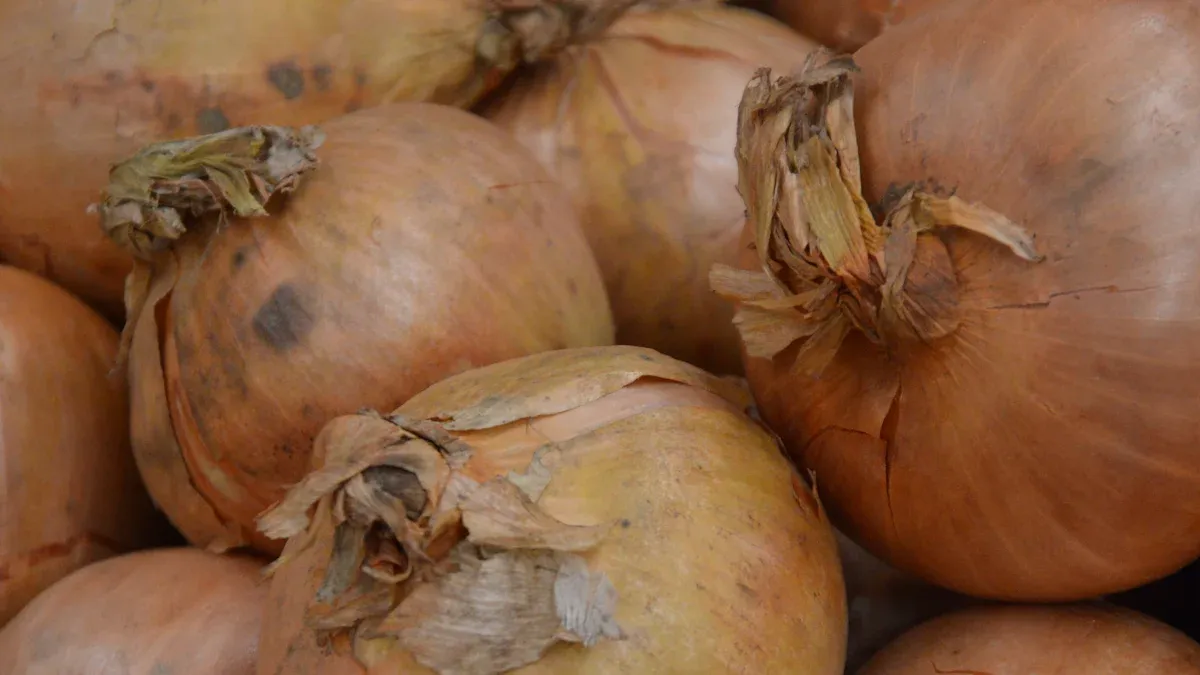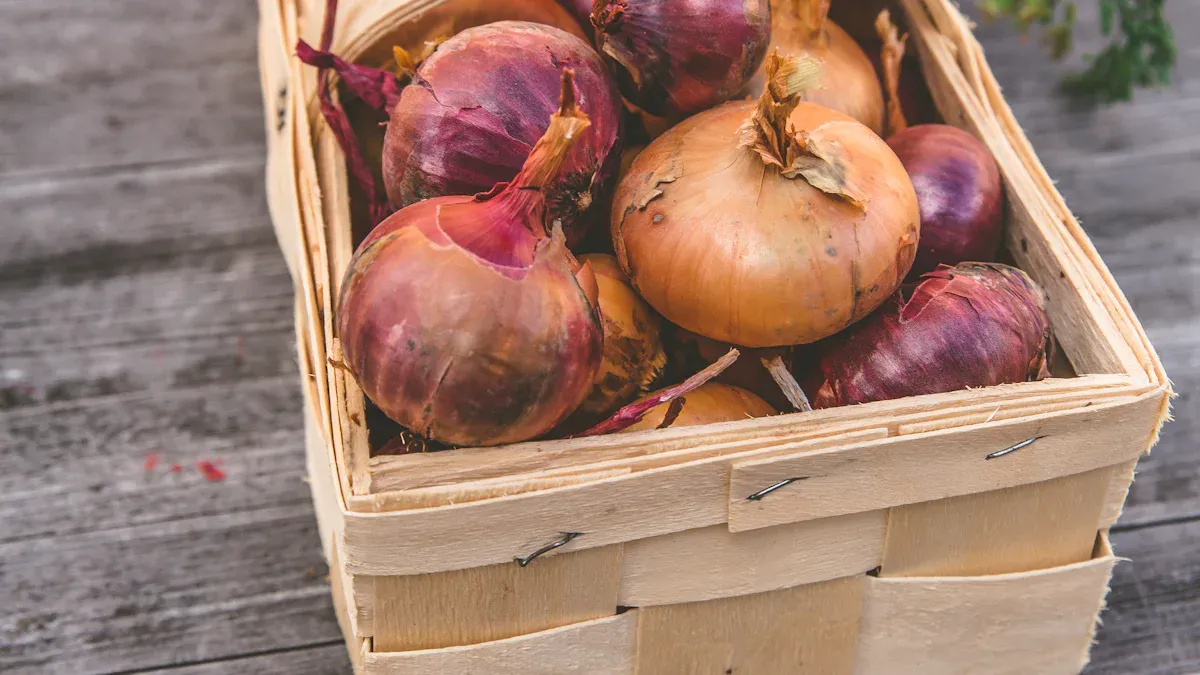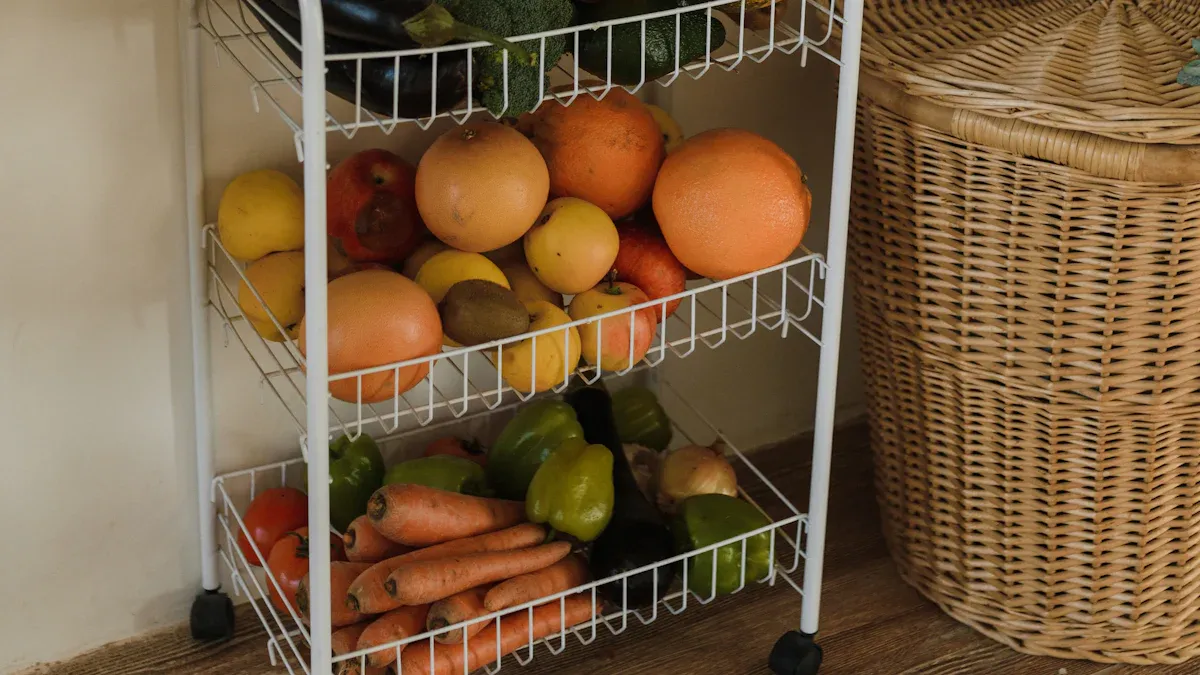The Ultimate Guide to Storing Onions for Long-Term Freshness

Have you ever wondered why your onions spoil so quickly? Storing onions properly is the secret to keeping them fresh and flavorful for longer. When you store them the right way, you not only preserve their quality but also reduce waste. Did you know that poor storage leads to a post-harvest loss of up to 30%? That’s a lot of fresh onions going to waste! By using simple techniques like Onion cold storage, you can enjoy their freshness for weeks and even help cut down on food loss.
Key Takeaways
Keep onions in a cool, dry spot. The temperature should be 40°F to 60°F to keep them fresh longer.
Use open storage like mesh bags or baskets. This stops moisture and mold from forming.
Do not store onions near potatoes. Potatoes release gas that can spoil onions.
How to Store Onions: General Guidelines
Best temperature and humidity for storing onions
To keep onions fresh longer, watch the temperature and humidity. Onions stay best in cool and dry places. The perfect temperature is between 40°F and 60°F (4.4°C to 15.6°C). Humidity should be around 65-70%. These conditions stop sprouting and rotting, helping onions last.
Here’s a simple table for onion storage:
Factor | Ideal Range |
|---|---|
Temperature | 40 to 60°F (4.4 to 15.6°C) |
Humidity | 65-70% |
Shelf Life | 30 to 180 days |
Keeping these conditions can make onions last much longer. If it’s too warm or damp, onions may spoil faster.
Why onions need dark and airy spaces
Onions need dark and airy spots to stay fresh. Light makes them sprout, and no airflow traps moisture. This can cause mold and rot. Use a basket or mesh bag to store onions. These allow air to flow and keep onions dry.
Don’t use sealed containers or plastic bags for onions. These hold moisture and make onions spoil. Instead, pick a cool, dark pantry or cellar corner for storage.
Keep onions away from potatoes and other foods
Did you know storing onions near potatoes makes them spoil faster? Potatoes release a gas called ethylene. This gas makes onions ripen and sprout quickly.
To prevent this, store onions and potatoes apart. Potatoes last up to two months at room temperature. But when chilled, they release more ethylene. This can ruin onions fast. Keep them separate to help both stay fresh longer.
Storage Methods for Different Types of Onions

Best practices for yellow, red, and white onions
Yellow, red, and white onions are pantry staples, and storing them correctly can extend their shelf life. You’ll want to keep these onions in a cool, dark, and well-ventilated space. A pantry or cellar works great. Use mesh bags, baskets, or even pantyhose to store them. These allow air to circulate, which prevents moisture buildup.
Avoid stacking onions on top of each other. Instead, spread them out to reduce the risk of bruising. Check them regularly for soft spots or mold. If you find a bad onion, remove it immediately to protect the others.
How to store green onions for maximum freshness
Green onions, also called scallions, need a different approach. These delicate onions thrive in the refrigerator. Wrap the roots in a damp paper towel and place them in a plastic bag. This keeps them hydrated and fresh for up to a week.
Want them to last even longer? Store green onions upright in a glass of water, like a bouquet. Cover the tops loosely with a plastic bag and place the glass in the fridge. Change the water every few days to keep them fresh.
Tips for sweet onions and their shorter shelf life
Sweet onions, like Vidalia or Walla Walla, have a higher water content. This makes them more prone to spoilage. To extend their shelf life, wrap each onion in a paper towel to absorb excess moisture. Store them in a single layer in a cool, dry place.
If you live in a humid area, consider refrigerating sweet onions. Place them in the crisper drawer, but keep them away from other produce. This helps maintain their flavor and texture for as long as possible.
Pro Tip: Freeze chopped sweet onions if you can’t use them quickly. They’ll stay good for months and are perfect for cooking.
Common Mistakes to Avoid When You Store Onions
Using plastic bags or sealed containers
Putting onions in plastic bags or sealed containers is a bad idea. Onions need air to stay fresh. Plastic traps moisture, which causes mold and rot. This can make your onions go bad quickly.
Did you know onions can absorb moisture from nearby vegetables? This makes both the onions and other veggies spoil faster. To stop this, use breathable storage like mesh bags, baskets, or pantyhose. These let air flow and keep onions dry and fresh.
Tip: Don’t vacuum-seal raw onions. It can cause harmful bacteria like C. botulinum to grow.
Refrigerating whole onions unnecessarily
You might think the fridge is good for onions, but it’s not. Whole onions don’t do well in the refrigerator. Cold air can ruin their flavor and texture. Instead, keep them in a bowl on the counter or in a pantry. This keeps them fresh for weeks.
The fridge also causes moisture buildup, leading to sprouting or rotting. Only refrigerate cut or peeled onions. Whole onions should stay in a cool, dry place.
Storing onions near moisture or heat sources
Moisture and heat are bad for onions. Keeping onions near sinks, stoves, or sunny spots makes them spoil faster. Heat makes them ripen quickly, and moisture causes mold.
To keep onions fresh, store them in a dry, airy spot away from heat or water. A pantry or cellar is a great choice. Check your onions often and remove any with soft spots or mold. This helps them last longer and reduces waste.
Onion Cold Storage: Tips for Cut or Peeled Onions

Storing cut onions in the refrigerator
When you cut an onion, its freshness clock starts ticking. The best way to store cut onions is in the refrigerator. Place them in an airtight container or wrap them tightly with plastic wrap. This keeps them from drying out and prevents their strong smell from spreading to other foods.
However, storing cut onions in the fridge for too long can lead to a loss of flavor. If you’re wondering how to store onions for maximum taste, use them within 7-10 days. For longer storage, freeze onions instead. Chopped onions freeze well and are perfect for cooking later.
Preventing peeled onions from drying out
Peeled onions can dry out quickly if left exposed. To keep them fresh, wrap them in plastic wrap or place them in a resealable bag. Store them in the refrigerator to maintain their moisture and texture.
If you want to extend their shelf life even further, consider freezing them. Simply chop the peeled onions, spread them on a baking sheet, and freeze. Once frozen, transfer them to a freezer-safe bag. This method ensures they don’t clump together, making it easy to grab just what you need.
Safe storage duration for cut or peeled onions
Cut or peeled onions don’t last as long as whole ones. In the refrigerator, they stay fresh for about a week. If you freeze onions, they can last up to six months without losing quality.
Always check for signs of spoilage before using stored onions. If they smell off, feel slimy, or have mold, it’s time to toss them. Proper onion cold storage not only extends their shelf life but also ensures your meals stay flavorful and safe.
How to Tell If Onions Have Gone Bad
Signs of spoilage like mold, soft spots, or foul smell
Wondering if your onions are still good? Look for clear signs of spoilage. Mold is one of the most obvious indicators. It often appears as fuzzy patches in white, green, or black. Soft spots are another red flag. When you press on the onion, it should feel firm. If it feels squishy or leaks liquid, it’s time to toss it.
Pay attention to the smell too. Fresh onions have a sharp, slightly sweet aroma. If your onion smells sour or rotten, it’s no longer safe to use. Trust your senses—they’re your best tools for spotting bad onions.
Identifying sprouting and what it means
Have you noticed green shoots growing from your onions? This is sprouting, and it happens when onions are stored for too long or in the wrong conditions. While sprouted onions aren’t harmful, they lose flavor and texture. The sprouts take nutrients from the bulb, leaving it dry and less tasty.
You can still use sprouted onions in cooking, but remove the sprouts first. For the best flavor, try to use onions before they sprout.
When to discard onions for food safety
Not all onions are worth saving. If you see mold, soft spots, or a foul smell, discard the onion immediately. Sprouted onions are safe to eat, but if the bulb feels mushy or has a slimy texture, it’s better to throw it away.
Always check your onions before using them. Eating spoiled onions can ruin your dish and may even cause foodborne illness. When in doubt, it’s safer to toss it out.
Proper onion storage isn’t just about keeping them fresh—it’s about preserving their quality and reducing waste. By following these simple tips, you’ll enjoy flavorful onions for weeks. Why wait? Start using these methods today and see the difference in your kitchen. Your onions will thank you! 🧅
FAQ
How long can onions last in storage?
Onions can last 1-6 months, depending on the type and storage method. Sweet onions spoil faster, while yellow onions last longer in cool, dry places.
Can you freeze onions for long-term storage?
Yes! Chop onions, spread them on a baking sheet, and freeze. Once frozen, transfer them to a freezer-safe bag. They’ll stay fresh for up to 6 months.
Tip: Frozen onions work best for cooking, not raw dishes.
What’s the best way to store onions without a pantry?
Use a mesh bag or basket in a dark, cool corner of your kitchen. Avoid sunlight and heat sources like stoves or ovens to keep them fresh longer.
See Also
Establishing A Cold Storage Space For Fresh Produce
Solving Storage Challenges With Versatile Cold Storage Solutions
The Importance Of Cold Rooms For Fresh Product Quality

